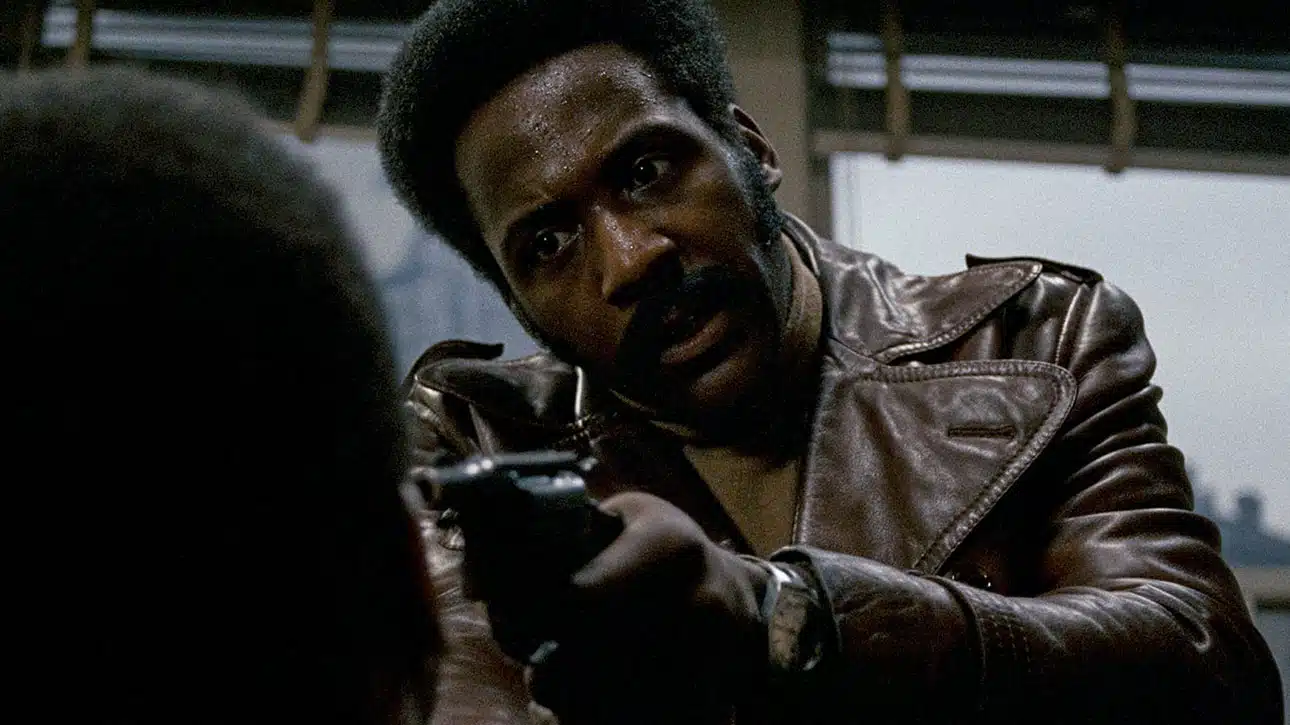
Regarded as the first film to precipitate the popular blaxploitation wave of the 1970s, Shaft was responsible for the creation of that genre’s many tropes, as well as introducing its leading star, Richard Roundtree, into a burgeoning new market. The popularity of the film has always depended on Roundtree’s performance as the dry-witted, smooth-talking private eye who gets embroiled in a plot to rescue a gangster’s daughter held hostage by a rival gang. The less-popular aspect of Shaft, though one that has been increasingly discussed over the years, is the film’s racial depictions, viewed by some as problematic.
Shaft gave American cinema its first modern Black action hero, one that has been emulated over the years with little success, until Ryan Coogler’s Black Panther (2018). Much of the film’s strength rests in the charismatic sways of Roundtree’s performance, his ability to deliver swaggering braggadocio with salty humor. Shaft gave birth to a wave of Black-centric films in the ‘70s, which gave actors like Fred Williamson reliable platforms on which they could build a career. The film’s lingering issue, which has followed it from the time it was released in 1971 until now, is its depiction of the Black male in urban working-collar municipalities of the US. Director Gordon Parks‘ often imitated but never duplicated work has confirmed the influence and the ripple effect Shaft has had throughout the decades; it has also provided many interesting discussions on the representations of Black men in film, particularly in action-oriented dramas.
John Shaft (Roundtree) is a private eye with a stony exterior and a penchant for deviating from the rulebook. Shaft chases down criminals with little concern about the legal ramifications of violently detaining them and, one day, takes things too far by defenestrating a gangster – something he dismisses as an accident when questioned by his higher-ups. His lieutenant gives Shaft a pass and the P.I. returns to the streets where he runs into Bumpy (Moses Gunn), yet another gangster, who appeals to him for help.
Bumpy’s daughter has been kidnaped by a rival gang, Italian Mobsters, and he pleads with Shaft to bring her back home safely. Shaft reluctantly agrees, and his mission to track her down means that he’ll have to enlist the help of some Black militants to do the job. After a number of double-crosses, set-ups, and plot twists, Shaft finds his way to the Italian Mobsters’ hideout and works to marshal his resources in a knock-down, drag-out shootout. On the peripheries of the story, inching toward centerstage with creeping menace, is the threat of a race war between the two cultural groups – something that the private eye is coolly aware of as he works his way through the city and its various boroughs.
As a piece of entertainment, Shaft will appeal to those who have a particular taste for police procedurals of a more violent extraction. While not excessive in its bloodshed, the James Cagney posturing is evident in many of the film’s gunslinging mannerisms. Despite the bursts of violence throughout, Shaft is a surprisingly talky picture; its reputation for an all-out action-drama precedes it. If, in terms of entertainment, there is anything else to enjoy about Shaft, it’s the smart talk amongst the actors who make good use of some of the over-the-top banter. Much of Roundtree’s performance depends on his ability to assume an air of irreverence, a skill that he executes stylishly with the running quips and one-liners he’s given.
Shaft greatly benefits from its location scenery, shot in areas like Harlem, Greenwich Village, Times Square, and Hudson Street, circa the early ‘70s. Normally, films shot in these locations during this era evoke a sense of bustle and panic, with sardine-packed crowds that seem to fill the screen from end to end. Here, there is an odd sense of hypnotic calm, as though all peripheral characters are under some kind of numbing spell. It renders Shaft with an eerie air of composure amidst the panic and violence, as if to isolate these characters from their everyday, gritty existence and impress upon them a touch of surrealism.
Shaft’s visual aesthetic seems to be a linear montage of grimy, impromptu shots strung together with purposeful style. It isn’t overly flashy, but it sometimes gives the impression of the pages of a newspaper being casually flipped through – a design that seems befitting of the economical and hasty flow of a busy New York city street. Of course, the soundtrack must be mentioned; Isaac Hayes, the film’s musical composer, earned himself Academy Award nominations for Best Original Song and Best Original Dramatic Score, taking home the Oscar for Best Original Song. Funky, humorous, and pulsing with the life of the streets, Hayes’ music proves an apposite commentator on these characters’ hurried lives.
Shaft has had a few detractors since the time of its release. The issue of whether or not such a character like the one played by Roundtree helped to further amplify the stereotypes of Black men in film has been a topic throughout the decades. Very little of Shaft’s personal life, outside of his romantic trysts, is seen. He has a tasteful and mannered homelife and, like almost every other character in the film, he enjoys his cigarettes. Beyond that, however, there seems to be no indication of a man who, for all his intelligence, is more than just the sum of his violent and sexual proclivities.
Shaft’s working life onscreen portrays a man who, in order to serve justice, must take criminal sidesteps as a means to the desired end. This doesn’t negate the stereotypical belief that the Black community has inextricable ties to crime, particularly in impoverished districts. Criterion’s in-depth essay, written by scholar Amy Abugo Ongiri, outlines these issues and their place in the film’s 50-year history.
It’s important to note that Roundtree’s role was originally intended to be played by a white actor. As it’s been surmised by a number of critics, many of the character and plot contraptions had not been modified when a Black actor stepped into the role, making some of the situations in Shaft problematic. At times, Shaft seems aloof from the Black community, as though he is a stranger to it, despite its proximity to his work and neighborhood and, of course, the fact that he is of the very race.
Shaft also seems to align the Black Power movement with only violent measures, negating an entire belief system that advocates for equality in social, political, and economic sectors of society. Somewhat aware of this inconsistency, yet not willing to pointedly address it, the film’s marketers released some print ads (and reissues of the novel by Ernest Tidyman, on which the film is based) with a tagline that read: “Shaft has no prejudices. He’ll kill anyone – Black or white.”
Despite a number of these issues, however, there is a cynicism that imparts uncomfortable truths in the slightest of gestures beneath the gunslinging and cinematic street talk. Those gestures – be they a look, a posture, or some inflection of the voice – speak to the grievances of daily living as a Black person in racially-charged environments; they are articulated through a performance that is equal amounts studied and extempore by Roundtree, who flows with unrelenting motion in the quick turns of the narrative. Often consigned to the sorts of films that have pandered to his work in Shaft (and its many sequels), Roundtree has been overlooked as an actor whose natural moodiness might have been better put to use in more nuanced dramas.
Criterion’s release of Shaft offers a clean, crisp transfer that, while it shows its early ‘70s age, is free of any dirt or contrast issues. As typical of its era in filmmaking, the film is heavy on grain. However, this gives it a nice, gritty texture befitting of the story, particularly in its color scheme; a minimalist palette of pumpkin oranges and chestnut browns that curiously seem to saturate the entirety of New York. Sound and dialogue are clear and present no issues. Optional English subtitles are also available.
Best of all are the supplements, of which Criterion has been generous. The most vital supplement here is the inclusion of Shaft’s Big Score, the 1972 follow-up to the film, presented in full and featuring behind-the-scenes footage. There are a series of interviews with Roundtree, director Parks, Isaac Hayes, and costume designer Joseph G. Aulisi. A number of documentaries round out the package, along with the beautifully-written booklet essay by Ongiri.
Roundtree’s star-making turn in the titular role has ensured that Shaft’s appeal extends beyond its era so that it now stands not as a relic of gritty ‘70s crime-drama cinema, but as a candid document of its time and culture. There has been a slew of lesser imitations of Park’s film, but none have cut it close. Shaft has become incontestably Roundtree’s own through a performance that seems not only natural and off-the-cuff but imbued with a sense of street life observed with true insight. As an officer of the streets with a keen ear to the pavement, Roundtree’s rendering of the percipient Black action hero remains unchallenged: he hears your footsteps long before you arrive.


